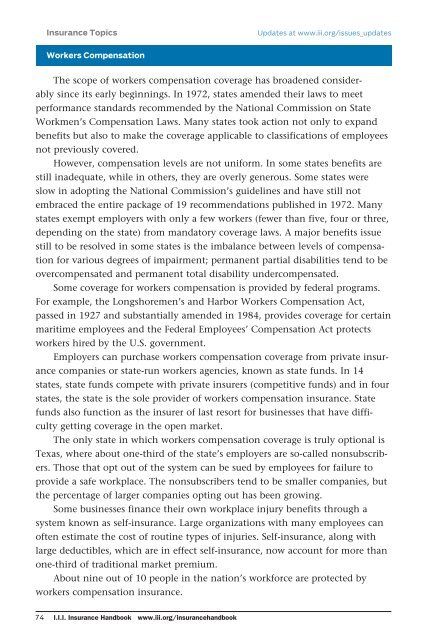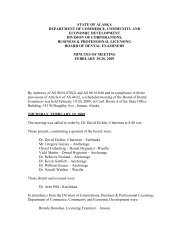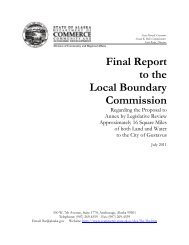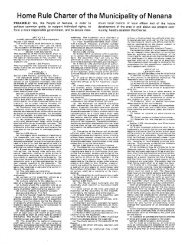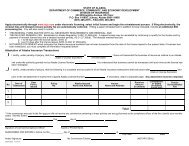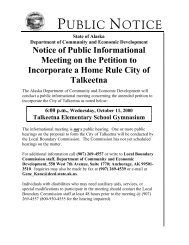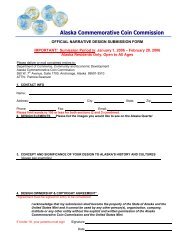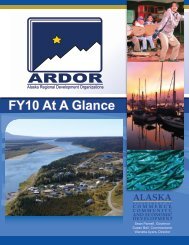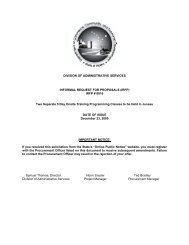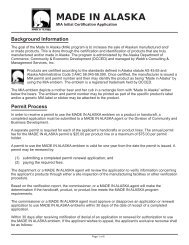Insurance Handbook - Alaska Department of Community and ...
Insurance Handbook - Alaska Department of Community and ...
Insurance Handbook - Alaska Department of Community and ...
You also want an ePaper? Increase the reach of your titles
YUMPU automatically turns print PDFs into web optimized ePapers that Google loves.
<strong>Insurance</strong> Topics Updates at www.iii.org/issues_updates<br />
Workers Auto <strong>Insurance</strong> Compensation<br />
The scope <strong>of</strong> workers compensation coverage has broadened consider-<br />
ably since its early beginnings. In 1972, states amended their laws to meet<br />
performance st<strong>and</strong>ards recommended by the National Commission on State<br />
Workmen’s Compensation Laws. Many states took action not only to exp<strong>and</strong><br />
benefits but also to make the coverage applicable to classifications <strong>of</strong> employees<br />
not previously covered.<br />
However, compensation levels are not uniform. In some states benefits are<br />
still inadequate, while in others, they are overly generous. Some states were<br />
slow in adopting the National Commission’s guidelines <strong>and</strong> have still not<br />
embraced the entire package <strong>of</strong> 19 recommendations published in 1972. Many<br />
states exempt employers with only a few workers (fewer than five, four or three,<br />
depending on the state) from m<strong>and</strong>atory coverage laws. A major benefits issue<br />
still to be resolved in some states is the imbalance between levels <strong>of</strong> compensation<br />
for various degrees <strong>of</strong> impairment; permanent partial disabilities tend to be<br />
overcompensated <strong>and</strong> permanent total disability undercompensated.<br />
Some coverage for workers compensation is provided by federal programs.<br />
For example, the Longshoremen’s <strong>and</strong> Harbor Workers Compensation Act,<br />
passed in 1927 <strong>and</strong> substantially amended in 1984, provides coverage for certain<br />
maritime employees <strong>and</strong> the Federal Employees’ Compensation Act protects<br />
workers hired by the U.S. government.<br />
Employers can purchase workers compensation coverage from private insurance<br />
companies or state-run workers agencies, known as state funds. In 14<br />
states, state funds compete with private insurers (competitive funds) <strong>and</strong> in four<br />
states, the state is the sole provider <strong>of</strong> workers compensation insurance. State<br />
funds also function as the insurer <strong>of</strong> last resort for businesses that have difficulty<br />
getting coverage in the open market.<br />
The only state in which workers compensation coverage is truly optional is<br />
Texas, where about one-third <strong>of</strong> the state’s employers are so-called nonsubscribers.<br />
Those that opt out <strong>of</strong> the system can be sued by employees for failure to<br />
provide a safe workplace. The nonsubscribers tend to be smaller companies, but<br />
the percentage <strong>of</strong> larger companies opting out has been growing.<br />
Some businesses finance their own workplace injury benefits through a<br />
system known as self-insurance. Large organizations with many employees can<br />
<strong>of</strong>ten estimate the cost <strong>of</strong> routine types <strong>of</strong> injuries. Self-insurance, along with<br />
large deductibles, which are in effect self-insurance, now account for more than<br />
one-third <strong>of</strong> traditional market premium.<br />
About nine out <strong>of</strong> 10 people in the nation’s workforce are protected by<br />
workers compensation insurance.<br />
74 I.I.I. <strong>Insurance</strong> <strong>H<strong>and</strong>book</strong> www.iii.org/insuranceh<strong>and</strong>book


